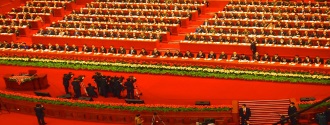China’s operating nuclear generating capacity will double over the next five years under the country’s latest Five-Year Plan.
The plan also calls for the preparation for construction of inland nuclear power plants and work on a reprocessing plant to start by 2020.
The ruling Communist Party of China’s National People’s Congress endorsed the draft of 13th Five-Year Plan at its annual session earlier this month. The plan will be officially implemented in the next few months. A summary of the plan lists several targets in the field of nuclear energy.
Firstly, China will complete construction of the four AP1000 units currently under construction at Sanmen in Zhejiang province and at Haiyang in Shandong province. Sanmen unit 1 is expected to be the first AP1000 to begin operating, in September, while Haiyang 1 is expected to start up by the end of the year. Containment tests have already been successfully conducted at both units. All four Chinese AP1000s are scheduled to be in operation by the end of 2017.
The plan also calls for construction of demonstration Hualong One projects at China National Nuclear Corporation’s Fuqing plant in Fujian province and China General Nuclear’s Fangchenggang plant in Guangxi to be completed by 2020. First concrete for Fuqing 5 was poured last May, while construction on unit 6 began in December. Fuqing 5 and 6 are scheduled to be completed in 2019 and 2020, respectively. Construction of Fangchenggang 3 also began in December, while construction of unit 4 is scheduled to begin later this year. Those two units are also expected to start up in completed in 2019 and 2020, respectively.
The start of construction of a demonstration CAP1400 plant in Shidaowan, Shandong province, is also set to begin under the 13th Five-Year Plan. The CAP1400 is an enlarged version of the AP1000 pressurized water reactor developed from the Westinghouse original by State Nuclear Power technology Corporation with consulting input from the Toshiba-owned company. As one of China’s 16 strategic projects under its National Science and Technology Development Plan, the CAP1400 is intended to be deployed in large numbers across the country. The reactor design may also be exported.
Site preparation is already underway for two demonstration CAP1400 units at Huaneng Group’s Shidaowan site. The pouring of first concrete is expected to take place soon.
The latest Five-Year Plan also calls for construction of Phase III of the Tianwan plant in Jiangsu province to be accelerated. The State Council gave its approval for Tianwan units 5 and 6 – featuring 1080 MWe ACPR1000 reactors – in December. Tianwan units 1 to 4 are Russian-supplied VVER reactors.
Construction of Tianwan 5 and 6 was originally scheduled to start in early 2011. However, following the March 2011 accident at Japan’s Fukushima Daiichi plant, the Chinese government suspended the approval of new nuclear power projects. The Tianwan Phase III units were amongst those suspended.
In October 2012, premier Wen Jiabao announced that China would “steadily return to normal construction” of new nuclear power plants, based on a “steady advance in an orderly manner”. The construction of previously approved projects began shortly afterwards.
Officially covering the period 2011-15, China’s 12th Five Year Plan called for a “small number” of nuclear projects to be approved each year after full discussion. With only coastal plants being approved, significant rescheduling was made for inland projects at Taohuajiang, Xianning and Pengze, which had previously been expected to start construction before 2015.
The new plan also calls for the start of construction of a new coastal power plant, the location of which is not disclosed. It also says that preparatory work for inland plants will also be carried out.
Under the latest Five-Year Plan, China should have some 58 GWe of nuclear generating capacity in operation by 2020, up from the current capacity of almost 27 GWe. In addition, a further 30 GWe of nuclear capacity will be under construction by 2020.
The 13th Five Year Plan also calls for the construction of a demonstration as well as a large commercial scale reprocessing plant to be accelerated.
China National Nuclear Corporation (CNNC) and France’s Areva signed an agreement in November 2007 to assess the feasibility of setting up an 800 tonne per year reprocessing plant for used fuel in China. This was followed by an industrial agreement for the project in November 2010, while in April 2013 a further agreement was signed setting out the technical specifications for the plant. Then in March 2014 another agreement was signed to continue planning the project and to complete the business case for it. A memorandum of understanding followed, in June 2015, which Areva said “formalizes the end of technical discussions, defines the schedule for commercial negotiations and confirms the willingness of both groups to finalize the negotiations in the shortest possible timeframe.”
Last September, CNNC said that it is selecting a site for the facility. Jinta county, north of Jiayuguan in Gansu province, had earlier been touted as a potential site for the complex. It also said construction of the reprocessing facility was expected to start in 2020 and to be completed in 2030.








































